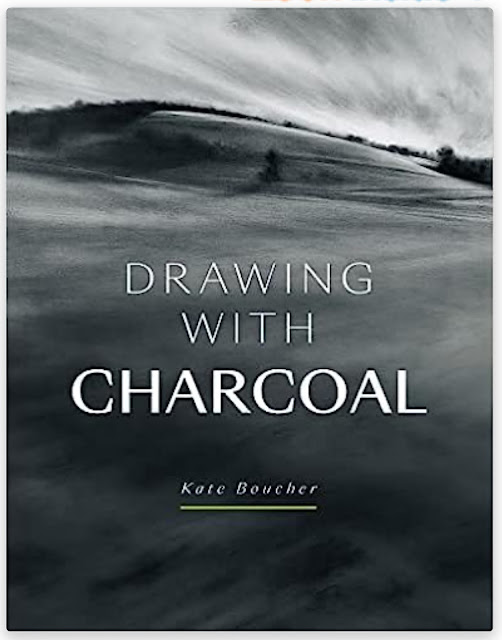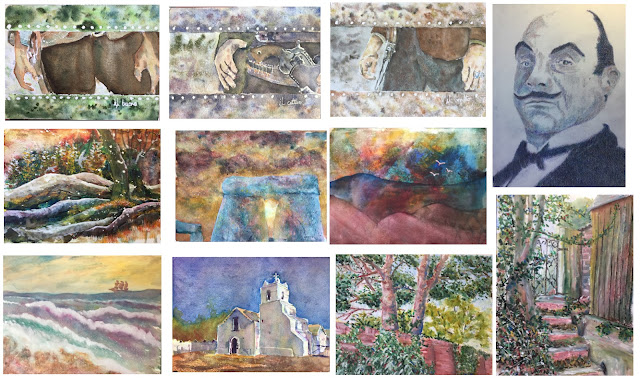A blog to show off the work of the Artistic Actuary. With the odd book review thrown in.
Media and subjects
- Watercolour (359)
- Landscapes (279)
- Portraits (245)
- Markers (137)
- Figures (117)
- Inktense Pencils (105)
- Abstract/Crazy (64)
- Supergranulators (59)
- Oil pastels (49)
- Coloured Pencils (45)
- Posterised Style (42)
- Inks (27)
- Series/Collections (21)
- Artgraf (19)
- Dash & Splash (18)
- Crackle Paste (10)
- Charcoal (9)
- Pencil (8)
- Collage (5)
- Jig-Art (4)
Sunday 30 July 2023
Looking For Source Material For Charcoal
Saturday 29 July 2023
AveryA
I picked out this pose by AveyA because it would give me the opportunity to paint a couple of hands, something I thought I needed to do after reading the Eddie Armer book. It's tempting to charge through my stack of birthday books, making whites and posting reviews but it's a better learning experience for me if try putting some of this stuff into practice as quickly as possible. Hence hands. As my order of charcoal paraphernalia from Jackson’s still hasn't been dispatched, it might be a while before I can try out the charcoal, so hands it is.
After getting down an initial drawing, I stared by putting down deep indigo in the darkest areas. I then assed in some sea blue in the mid value areas and areas where dark shapes covered adjacent areas on the body and the background. Maybe I should habe just merged dark shapes in the background and on the body - I'd have had no hesitation doing this in watercolour. And then I remembered an idea from the Kate Boucher book on adding little bits of colour to a monotone painting and thought I'd try this out by adding some poppy red in places. But I screwed up by adding too much of the red. Oh well.
After wetting all the marks, this point I stood back from the painting and asked myself whether it was finished. Well I liked Avery's left hand but not her right and thought that both would benefit from having some sketchy outlining added. I picked out a new colour, bright blue, for the outlines and added them all over the painting. To keep things harmonious, I also added some light blue shading with the side of the pencil to the background. Then I had second thoughts, thinking the outlining looked too sharp. So I added some bright blue shading to outlines around the background and poppy red shading to outlines around the body.
After wetting this second set of marks I could see that the bright blue was much more vivid than I was expecting. Maybe it's a pthalo blue, because that (as Winsor blue green shade) is highly pigmented as a watercolour. But, because any more marks would have made things worse, I stopped painting at this point.
Avery's left hand and forearm are close to perfect here, making this a worthwhile exercise. But everything else is a bit bleugh with no redeeming features. Outlining almost never works for me in these paintings and there's a disconnect between the body and he background. This one won't be going in the shop window.
I might just need to take a break until I can get started with the charcoal.
Thursday 27 July 2023
Drawing With Charcoal, Kate Boucher – Book Review
Drawing Hands & Feet, Eddie Armer – Book Review
Wednesday 26 July 2023
Birthday Stash 2023
Tuesday 25 July 2023
101 Textures In Colored Pencil. Denise J. Howard – Book Review
Friday 21 July 2023
Tundra Colours
Thursday 20 July 2023
Look Over Yonder
Wednesday 19 July 2023
Sky Above Hartlip Church
Tuesday 18 July 2023
Miriam
Thursday 13 July 2023
A Hot Day In Nuuk
Wednesday 12 July 2023
Abandoned Quarry Ruins, Carbilly Tor, Bodmin Moor
Tuesday 11 July 2023
Upchurch Craft Fair
Adhira
I started by putting down a 3x4 grid and marking out an outline in pencil. For once I trusted my eye to fill out the grid with shapes rather than using a ruler to accurately pin down important points. Then came the colours. I started with the body, intending leave the background white. I stabbed in lots of spots in lots of different colours. Some of these were impressionistic colours I could see in the source photo, some were dark or light colours inspired by the values in the source photo, some were sensible local colour and some were just random. The random colours were often greens as I'm working from a set of oil pastels designed for landscapes. I was intending to keep the lightest places white but that didn't really happen. In fact I ended up putting in a layer of white stabs but these, rather than being vertical stabs resulting in spots, were angled stabs that began smearing out some of the darker spots underneath. And finally, of course, I mixed all the colours together using a rubber tool on a stick in detailed areas and my fingers everywhere else. With the fingers, I was trying to sculpt the body with finger strokes both along and around cylindrical shapes.
For the hair, I just kept throwing in whichever colours I felt like at the time. At one point my fingers were mixing it into quite a muddy colour, so I scraped off a lot of the paint, added on a few stabs of my favourite colours and gave it a minimal mixing with my finger. I think I managed to rescue the hair from disaster but it was looking close at times and there are lessons there for me about the dangers of mixing too many colours in this medium.
I added the background at the end after seeing far too many finger prints on the paper. I stabbed in some blue, red and green spots, then started the mixing by stabbing yellow and white into them at an angle, just like I did with the white on the body.
After stepping back, I decided that Adhira's right shoulder was looking too pale compared to the rest of her body, so stabbed in some pinks and blues and mixed them in with a finger. And that was me done.
It's a decent effort, with lots of the individual components of the impressionistic flesh tones still visible. I like that. Adhura's right hand isn't brilliant but I guess if someone didn’t like it, they could still buy the painting, crop it and put it in a square frame. I've given the game away there: this one's up for sale.

























